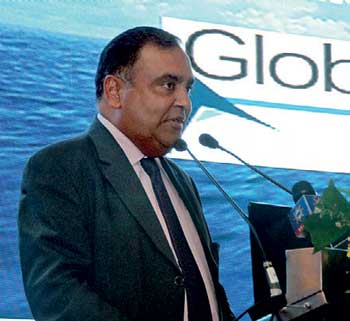The Indian government is requesting Indian companies to invest in the Colombo Port, Indian High Commissioner in Sri Lanka Y.K. Sinha told a maritime forum in Colombo yesterday.
 “We have encouraged Indian companies to invest in the expansion of the Colombo Port and that is why we believe, as an article of faith, the expansion of the Colombo Port will be good for Sri Lanka, good for India and good for the region,”
“We have encouraged Indian companies to invest in the expansion of the Colombo Port and that is why we believe, as an article of faith, the expansion of the Colombo Port will be good for Sri Lanka, good for India and good for the region,”
he told Colombo International Maritime Conference, which kicked off yesterday afternoon. Aitken Spence Maritime, Freight and Logistics Chairman Dr. Parakrama Dissanayake noted that the expressions of interest for the Colombo Port’s latest East Container Terminal has a requirement that at least 20 percent of any consortium bidding should be owned by India, Pakistan or Bangladesh.
“A geopolitical equation is at play,” he said. Ports and Shipping Minister Arjuna Ranatunga had recently said that he would like a greater presence of India in the Colombo Port and that the two Chinese companies, which had expressed interest in the East Container Terminal, would have to partner with the South Asian parties.
This could be to counter the influence being projected in the Colombo Port by the Chinese-owned Colombo International Container Terminal (CICT), which has a 2.4 million 20-foot equivalent unit (TEU) capacity and the ability to service 18,000 TEU container ships.
Concerns are also rising about the influence of China across the country, since the world’s second largest economy is Sri Lanka’s largest financier with over US $ 400 million in annual investments focused on infrastructure and recently pledging to invest over US $ 5 billion in industrial projects as well. Hauer Associates India Senior Partner S.N. Srikantha noted that many see the trade relationship between India, China and Sri Lanka are akin to the relationship between a wife, a husband and a mistress, as seen in the popular Hindi movie ‘Pati Patni Aur Woh’, which is not true.
“India and China are not on a see-saw. Not that when one is down the other goes up. They are on a swing. They will go up at the same time and come down at the same time. Guess who facilitates that? Sri Lanka,” he said. The East Container Terminal and another container terminal to be planned in the future are set to have similar capacities that CICT has.
Sinha noted that even though the Indian government is now heavily investing in local ports in an attempt to cater to the fast-growing Indian economy, which many think would make Colombo irrelevant, he said that such fears are unfounded, since the developments are not enough to handle future Indian traffic. “At the rate India is growing, I think India would need all the ports it can use for transporting or receiving its cargo. So I think in that context, the Colombo Port in the foreseeable future will play an extremely important role,” he said.
India’s former Shipping Secretary Michael Pinto said that India’s gross domestic product and shipping would grow due to the ‘Make in India’ policy, under which there will be a nationwide Goods and Services Tax (GST) instead of numerous region-based taxes starting in 2017.
Dr. Dissanayake noted that the new container terminal in Kochi has not threatened Colombo despite two years of operations and that the effects the Vizhinjam and Enayam ports currently under construction will have on Colombo are too early to tell. Around 70 percent of Colombo’s container shipping volume is from Indian transhipment and the CICT and the other privately-owned terminal, South Asian Gateway Terminal had over two thirds of the Colombo container traffic market share. Maersk Lanka Country Manager Zeeshan Mukhi noted that even though the Colombo Port’s volumes grew by 12 percent for the first half of 2016, the threats to the port are from Sri Lanka’s lack of industry.
“The key concern in Sri Lanka is the low growth of Sri Lankan exports. This affects the decisions of shipping lines to come to Sri Lanka,” he said. (CW)

